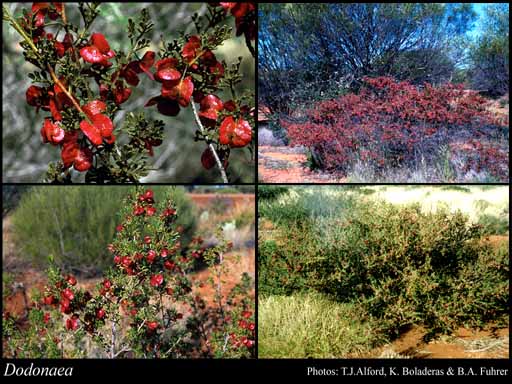- Reference
- Gard.Dict.Abr. Ed.3 (1754)
- Name Status
- Current

Scientific Description
Common name. Hopbushes. Family Sapindaceae.
Habit and leaf form. Trees (small), or shrubs; laticiferous, or non-laticiferous and without coloured juice. Stem internodes solid. Mesophytic. Leaves alternate (usually), or opposite (rarely); spiral; petiolate; non-sheathing; gland-dotted, or not gland-dotted; simple, or compound; pulvinate, or epulvinate; when compound, pinnate. Leaf blades if simple-dissected, dissected; pinnately veined; cross-venulate. Leaves without stipules. Leaf anatomy. Hairs present, or absent; glandular hairs absent, or present (rarely). Extra-floral nectaries absent. Stem anatomy. Secondary thickening developing from a conventional cambial ring, or anomalous.
Reproductive type, pollination. Fertile flowers hermaphrodite, or hermaphrodite and functionally female, or functionally male, or functionally female, or hermaphrodite, functionally male, and functionally female, or hermaphrodite and functionally male. Unisexual flowers present. Plants andromonoecious, or gynomonoecious, or dioecious, or polygamomonoecious, or polygamodioecious. Female flowers with staminodes (vestigial), or without staminodes. Male flowers with pistillodes, or without pistillodes.
Inflorescence and flower features. Flowers solitary, or aggregated in ‘inflorescences’; in cymes, or in racemes (short), or in panicles, or in fascicles (or clusters). The terminal inflorescence unit cymose. Inflorescences terminal, or axillary. Flowers pedicellate; bracteate (small, leaf-like); bracteolate, or ebracteolate; small; regular. Floral receptacle developing an androphore to developing a gynophore, or with neither androphore nor gynophore. Free hypanthium absent. Hypogynous disk present, or absent. Perianth sepaline (the corolla lacking); 3–6(–7); 1 -whorled. Calyx present; 3–6(–7); 1 -whorled; polysepalous; imbricate, or valvate; unequal but not bilabiate, or regular; when K5 with the median member posterior. Corolla absent. Fertile stamens present, or absent (female flowers). Androecial members definite in number. Androecium 4–20. Androecial members free of the perianth; free of one another; 2 -whorled, or 1 -whorled. Androecium of male-fertile flowers exclusively of fertile stamens. Stamens 4–20 (6–12 or rarely more); all more or less similar in shape; diplostemonous to triplostemonous; at disc margin or gynophore base, within the disc; filantherous. Anthers basifixed; more or less versatile; dehiscing via longitudinal slits; introrse; tetrasporangiate; appendaged, or unappendaged. The anther appendages apical (by connective extension). Fertile gynoecium present, or absent (male flowers). Gynoecium (2–)3–4(–6) carpelled. The pistil (2–)3–4(–6) celled. Carpels reduced in number relative to the perianth, or isomerous with the perianth. Gynoecium syncarpous; synovarious to eu-syncarpous; superior. Ovary plurilocular; (2–)3–4(–6) locular; sessile. Gynoecium stylate. Styles 1, or 2–4; free, or partially joined; attenuate from the ovary, or from a depression at the top of the ovary (??); apical. Placentation axile to basal. Ovules 2 per locule; funicled, or sessile; pendulous, or horizontal, or ascending; arillate, or non-arillate; hemianatropous, or anatropous, or campylotropous, or amphitropous.
Fruit and seed features. Fruit non-fleshy; dehiscent, or indehiscent (rarely not readily dehiscent); a capsule. Capsules valvular. Fruit 1–2 seeded (per cell). Seeds non-endospermic. Cotyledons 2. Embryo curved, or bent, or coiled.
Etymology. From Dodonaeus, latinised form of Rembert Dodoens (1517–85), Flemish physician and botanist, professor of medicine at Leiden.